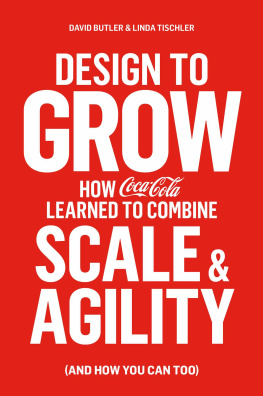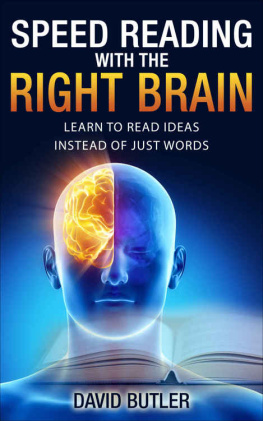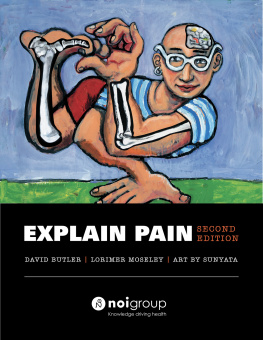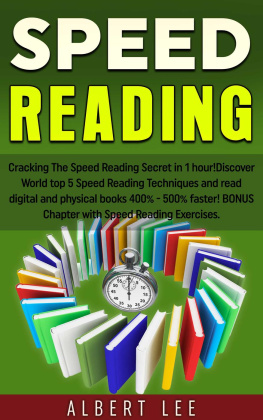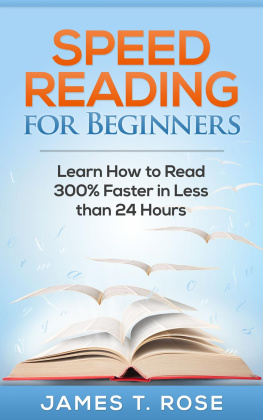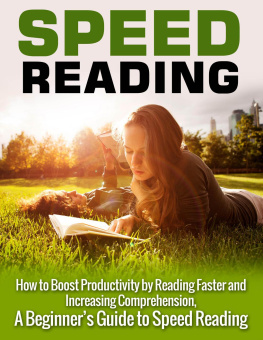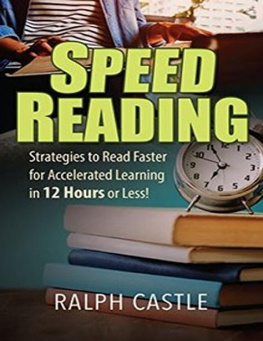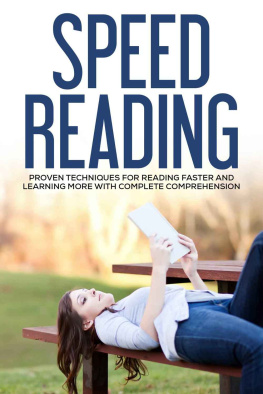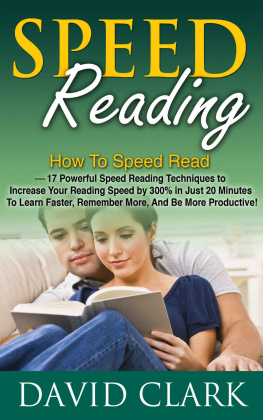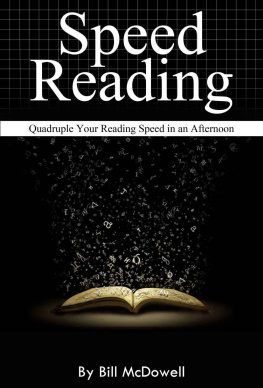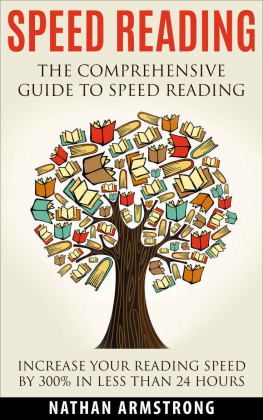READING WITH THE RIGHT BRAIN
Copyright 2014 David Butler
Praise for
READING WITH THE RIGHT BRAIN
Unlike many other speed reading strategies available, Reading with the Right Brain is not a gimmick; its a unique method that allows you to more effectively assimilate what you read in a shorter amount of time.
Amanda Johnson, M.A.,
Assistant Professor of English, Collin College, Plano, Texas
David Butler and I have been friends for five years and have enjoyed many interesting conversations about reading and comprehension. I have always found his thoughts on this subject to be incredibly unique and insightful. Reading with the Right Brain has given David a place to collect these ideas in one place, and make them easy to understand for anyone wishing to improve their reading skills.
This book includes not only original theories and techniques for reading improvement, but also a totally exclusive method of presenting practice exercises that makes it extremely easy to begin reading whole ideas at a time.
Pick up this book and start reading with your whole brain.
Richard Sutz, CEO,
The Literacy Company,www.EfficientReading.com,
Author of Speed Reading for Dummies
I strongly recommend David Butlers new book Reading with the Right Brain as one of the most innovate new approaches to speed reading on the market today. For the past year, Dave and I have discussed in email exchanges crucial issues about reading comprehension and the history of speed reading instructions. Daves unique approach emphasizes the importance of reading with the right side of the brain which helps the reader quickly comprehend a text by converting groups of words into images and concepts.
It is amazing to me that so much could have been written in so many years since Evelyn Wood about speed reading and no one came up with the idea of speed comprehension. All the other programs emphasize rapid eye movement over text, promising that comprehension would follow, which it usually didnt. The concept of focusing on comprehension first has been the missing link.
Reading with the Right Brain, is a must read for peoples interested in improving their reading comprehension and speed.
Dr. James Young,
Professor of English, Weber State University, Ogden, Utah
David Butler gets to the core of reading comprehension in Reading with the Right Brain, with effective techniques and exercises to focus your attention on meaning versus words. This book will speed up your reading, increase your comprehension, and make reading a pleasurable pursuit of new worlds of knowledge rather than slow torture that only leads to confusion. Read it and learn!
Danielle Ellis,
Mother, editor, and 6th grade teacher
Table of Contents
Introduction
I slammed the book shut. Why was I such a frustratingly slow reader? And why couldnt I remember what I read?
I was sitting in my yard, in the shade of the tall white birch trees, beneath the blue summer sky, reading a book I was very interested in. But I couldnt help getting angry at how much time the reading was taking me and how poor my comprehension was. How could I enjoy a book if I had to read it in slow motion? And then just forget it all?
This was me several years ago. And if this sounds like you, read on. I can show you how to read faster and understand more, by reading with more of your brain; specifically the powerful, intuitive, big-picture right hemisphere. Although not normally associated with reading, this side of your head has a unique capability of quickly visualizing and conceptualizing entire complex ideas.
Reading with the right brain is a technique which opened the doors to reading for me. This is not like any other technique you may have already tried; believe me, Ive tried them all. This is different.
This book is about learning to read conceptually and imagining and visualizing what you are reading. Reading conceptually is not just another speed reading trick, but a different way of thinking. By learning to use your right brains visualizing abilities, you can end the lazy habit of merely reciting words, and learn to really think about the ideas.
This book explains how stronger comprehension leads to faster reading, how the history of reading developed, and how the brain manages to accomplish this miracle. There is also a discussion on how to side-step bad reading habits and an examination of popular speed reading myths.
The jewel of this book though is the set of 20 unique reading exercises, which make it easy to learn to read with the right brain by guiding your attention to each of the short, meaningful pieces of information which sentences are made of. These specially formatted exercises will give you an easy way to experience how it feels to read faster and to read with better comprehension. By spending a little time practicing with these exercises, you can discover the power of reading with the right brain.
Frustration
I had always wished I was a better reader. I wanted to read more but I was so slow. I was interested in non-fiction books, especially history and science, but if the point of reading non-fiction was to acquire and retain knowledge, then this was probably the single least effective activity I ever engaged in. Not only was I slow, but after spending dozens of hours getting to the end of a book, I only retained the foggiest idea of what I had read.
I had always been frustrated by how much time my reading took. And no matter how much I read, I was still slow. I wanted to improve but didnt know how. Nothing I tried worked.
As a young boy, I would see advertisements that promised to teach me to "speed read." I dont remember what these courses cost, but it must have been more than I could afford on my allowance.
In high school, I finally had the chance to take a night course on speed readingone night a week for ten weeks. An impressive looking machine displayed text in short segments, one at a time, with a control for speed adjustment. It seemed like this should work for sure, but in the end it had no real effect. The faster the text displayed, the worse my comprehension was.
I tried several speed reading books and courses during high school, college, and beyond, but was always disappointed.
Reading well should have been in my genes. My father and mother were excellent readers. My mother loved to read fiction and my father loved non-fiction. My father was self-taught since 8 th grade, but because of his passion for reading, he could speak intelligently on practically any subject.
But it didnt look like I had inherited my parents reading skills. I also found it difficult to maintain concentration and I had a horrible memory. What was wrong with me? Maybe I just had a slow brain. Maybe I could never read faster.
Discovery
Then one day at the age of 49, in the summer of 2000, I was sitting in my yard trying to get through a book on the interesting science of fractals. But again, it was a struggle.
I couldnt stand it anymore. It seemed stupid to spend so much time reading with so little to show for it. I shut the book.
I sat holding the closed book, wondering if I should force myself to continue reading. I didnt know what to do. I would be a quitter if I gave up, but a fool to waste so much time on a beautiful summer day.
I reopened the book and stared at the page and then something interesting happened. As my mind idled, I began to notice patterns in the arrangement of the words. The rows of spaces seemed to form horizontal, slanted, and vertical lines that outlined blocks of words.

I played with this illusion for a while, but then this mental rest stop led me to wonder if there were patterns in the ideas too. Just as these clumps of words formed
Next page

